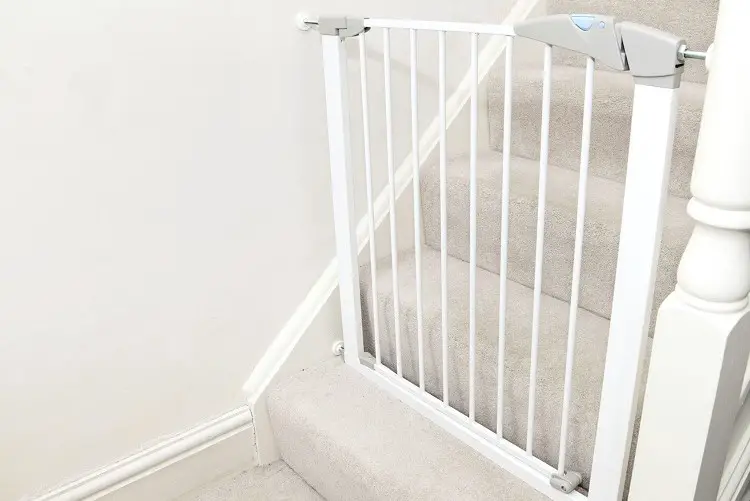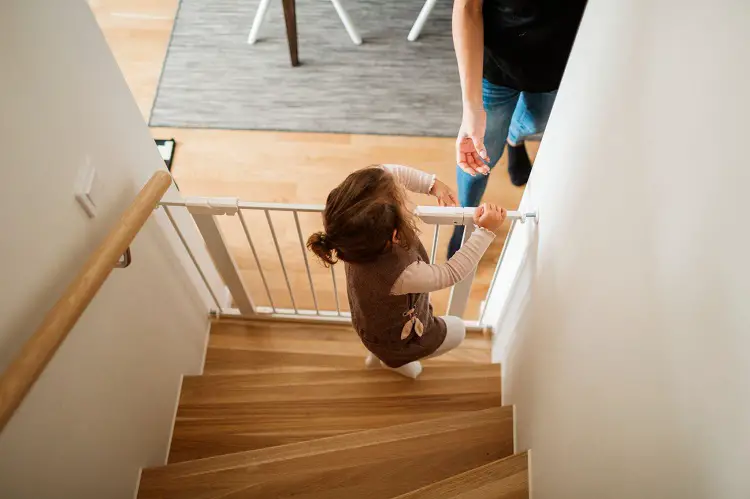If there is anything that should be your priority as a parent, it should be your baby’s safety. As your baby grows from newborn to toddler, to wonder about their safety and the possibility of childproofing your home.
If you wonder how to install baby gate at bottom of stairs, this article is for you.
A baby gate is an essential tool to have around your house if you have stairs in your home.
Baby safety gates can help ensure that you’re crawling and walking baby is protected from falling down the stairs.
Most baby gates are either hardware-mounted or pressure-mounted. Since different models require different installations, it’s important to read and follow the manufacturers’ instructions closely.
This article discusses simple ways to install a baby gate at the bottom of stairs.
How To Install Baby Gate At Bottom Of Stairs

When installing a baby gate at the bottom of stairs, it is best to use the pressure-mounted gate because they are the ideal baby gate for the bottom of stairs. The following steps will guide you on your installation.
1. Measure the opening where you’d like to place the gate
Basic pressure-mounted gates fit spaces between 26 inches (66 cm) and 38 inches (97 cm).
Measure the space you wish to block off and purchase the appropriate gate size.
You can purchase separate extensions or panels if you have a long area to gate off.
2. Extend the gate to fit the space
Some pressure-mounted gates, especially those with a door in the middle, will extend to meet the walls using small cups on each corner of the gate.
To install these models, ensure that your gate is placed into the opening and spin the bolts to extend the wall cups to meet the door frame or wall.
When there is no gap between the frame and the door handle, you will know that the gate has been correctly fitted.
A pressure-mounted baby gate may have two sliding panels that can be adjusted to fit the opening.
If this is the case, then you have to pull the panels away from one another until they extend to fill the entire doorway or wall space.
The pressure of the panels against the walls or door frame should hold the gate upright.
The bottom of the gate should be no more than 3 inches (7.6 cm) from the floor to prevent trapping hazards.
3. Lock the gate into place using the pressure bar if your model has one
The pressure bar is a locking mechanism to hold the gate in place. To use it, press the pressure bar toward the ground until it is straight.
After installing the gate, ensure the pressure bar is located on the side of the gate away from the child so your child can’t use it to climb up and over the gate.
An additional bar or locking mechanism is not found in all pressure-mounted baby gates, and this is to secure them into the space.
4. Test the gate repeatedly by pushing and pulling on it
If you want to be sure that the baby gate you installed is strong enough, you should test it by repeatedly pushing and pulling on it.
If it is properly fixed, then it should be able to withstand some pushing.
If it’s easy to knock the gate over, try lifting the locking mechanism and extending the panels, so they rest more snugly against the walls or door frame.
Once the gate is installed, check it regularly to ensure it remains stable.
Hint:
After you have successfully installed the gate, use it properly. Don’t try and climb over the gate rather than open it to go through.
You may catch your foot while trying to do this, which may lead to serious injury to you or your child if they are in your arms.
Remember, babies are smart. They watch everything we do; by climbing over a gate, you teach them this habit. This may prompt them to try to climb over it themselves one day.
If you’re still having trouble installing your baby gate, here is a Youtube video to guide you.
Things To Consider Before Installing Your Baby Gates
1. Put up gates before your baby starts crawling.
This is the first stage and first step because most babies begin crawling between 7 to 10 months, so experts believe it is best to install baby gates when your baby turns 6 months old.
There is no generalized age for babies to develop skills. Babies do so at different rates.
So always keep an eye out when your child starts experimenting with crawling to determine if you need to put gates up sooner.
Some may argue that it is a bit early, but you should be prepared beforehand so your baby does not take you unawares. All babies are different. Some babies progress from small or no movements to fast crawling fairly quickly.
There are times when babies skip the crawling stage and go directly to walking if this is the case with your child, then you have to wait until they are 8-12 months old before you install the gate.
2. Remove the baby gate when your child can get around it
Baby gates are generally safe and necessary for children between 6 months and 2 years old.
But sometimes, things happen very fast, and children develop skills at different rates, so once you notice that your child can climb over the safety gate or open it, you should know that removing it is paramount.
The next thing you do is to teach them how to navigate that area of your house safely.
3. Use pressure-mounted gates in less hazardous locations
Pressure-mounted gates are held across an opening by the pressure they exert against the door frame or walls.
These gates are suitable for areas where falling isn’t a significant concern, such as in a doorway between two areas with same-level flooring or at the bottoms of staircases to prevent children from climbing up the stairs and falling back down.
For example, you can use it to block off the pantry or kitchen, keeping your child away from hazardous foods or choking hazards.
You can also use it to separate your baby from any pets in your home until they’re more comfortable.
4. Find a gate that meets current safety standards
Buy a new gate certified by the Juvenile Products Manufacturers Association (JPMA).
If you have a used gate, ensure it meets current safety standards by checking product recalls from the U.S. Consumer Product Safety Commission.
Use a gate meant specifically for children. Do not reuse gates intended for pets.
Using Baby Gates in Other Areas
Apart from preventing falls down stairs, baby safety gates can serve as other types of gates that protect other areas in your house, such as:
- Rooms that are not childproofed or that you want to keep your toddler out of (like the kitchen)
- Rooms or places where your cat or dog spends time to separate the pet and the baby
Related Posts:
- How To Keep Cat Out of a Crib
- How To Stop Toddler From Slamming Door
- How To Childproof Toilet Paper Roll From Child
Wind Up
I am sure your question on how to install baby gate at bottom of stairs has been answered.
One of the first things you must do is always to read the manufacturer’s instructions.
Go through them and study them firsthand, and then use the additional information you have got here to boost and augment your knowledge, and before you know it, you have installed your baby’s gate at the bottom of the stairs.

